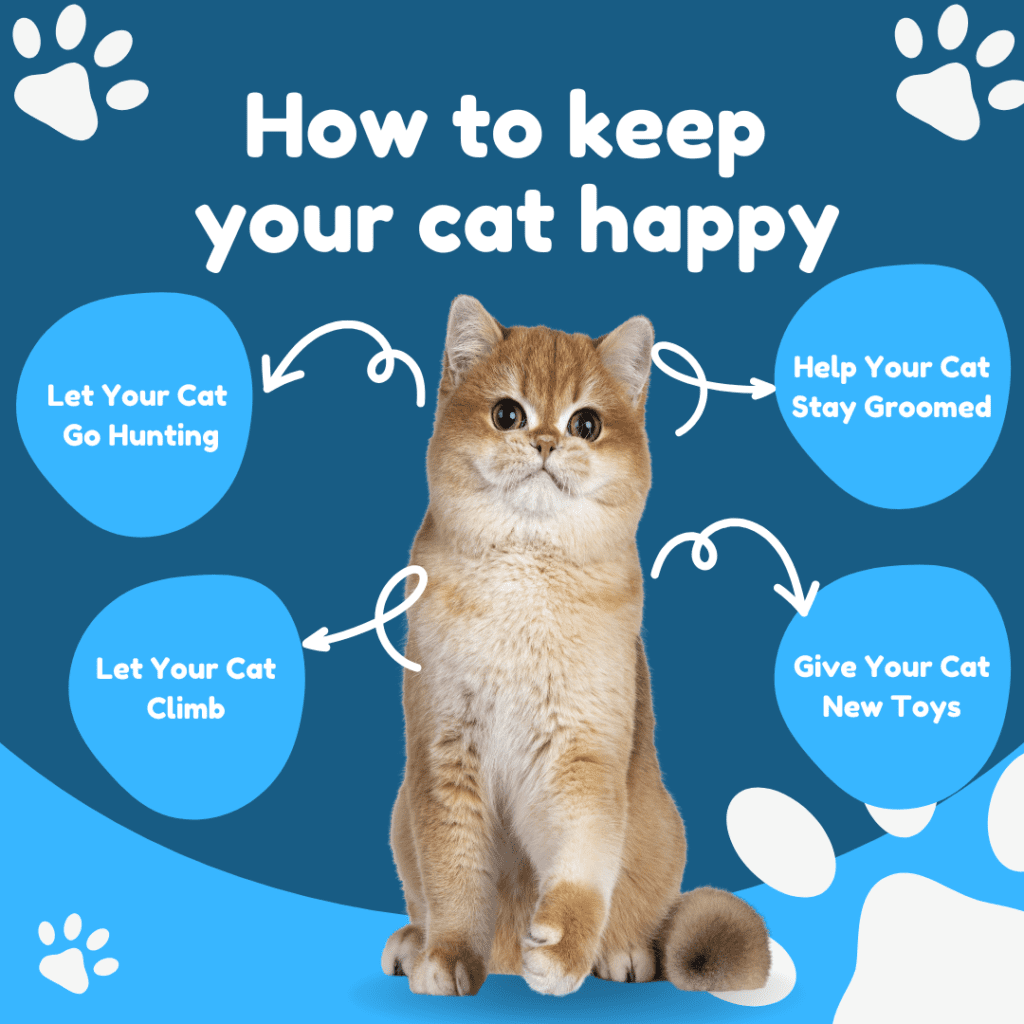Indoor cats can get bored. Fast. And when they do, you’re the one who ends up paying the price—literally—with shredded furniture or a sulky feline hiding under the bed. Many cat parents in the US work full-time or own businesses. They want their cats to live long, healthy lives—but also need ways to keep their cats mentally and physically active at home. If you’ve been asking yourself “how to entertain a cat indoors without turning your living room into a zoo?” You’re in the right place. Below are 10 realistic, simple tips to keep your cat happy without needing a full-time pet nanny or a cat-sized theme park.

1. Create Window Perches
Cats love looking outside because it’s like cat TV. Give them front-row seats.
Set up a perch near a window so your cat can watch birds, cars, or squirrels. Use a soft cushion on the window sill or install a suction-cup cat hammock. Multimedia idea: Include a photo of a cat lounging in a window hammock with a curious face. Data idea: Share a stat about how visual stimulation reduces indoor cat anxiety (e.g., “According to the American Veterinary Medical Association, visual enrichment can reduce behavioral issues in 40% of indoor cats.”)
2. Rotate Toys Every Few Days
Your cat gets bored of toys, just like kids do. Swapping them out feels like a brand-new game. Put out 3-4 toys at a time. Every few days, swap them with others. This keeps your cat curious and excited, especially when old favorites reappear.
3. Set Up a Bird Feeder Outside
Want to keep your indoor cat entertained for hours? Set up a bird feeder right outside a window. This simple step creates a safe, mess-free way for your cat to engage its natural hunting instincts—without any feathers flying in your living room. Place the bird feeder where your cat has a clear view. From fluttering wings to chirping sounds, the scene outside becomes a form of live entertainment. It’s like Catflix—only better.Why it works: Watching birds stimulates your cat’s brain and prevents boredom. This is a perfect solution for indoor cat enrichment and helps reduce destructive behavior caused by lack of stimulation.

Multimedia idea: Create a short video clip of a curious cat chirping or tail-twitching while watching birds through the window—it’s gold for Instagram reels!
4. Use Puzzle Feeders
A meal and a challenge = a mentally healthy cat.
Puzzle feeders make your cat “work” for food, mimicking the natural hunting experience. These feeders come in all shapes—from basic treat-dispensing balls to advanced mazes that require strategy. Start simple: Begin with easy food balls to spark interest. Gradually introduce more complex puzzles to keep the challenge fresh. Vet Insight: According to VCA Hospitals, food puzzles can reduce obesity and prevent boredom-related behaviour in cats by promoting mental stimulation.
Bonus Tip: Rotate puzzle toys weekly so your cat doesn’t get used to just one type. This keeps feeding time fun and enriching.
5. Build Vertical Spaces
Running out of room? Build up, not out.
Cats naturally seek high ground to observe their territory. Giving your cat vertical territory—like cat trees, shelves, or mounted steps—turns your home into a feline-friendly jungle gym.
Benefits of vertical space:
-
Boosts confidence, especially in multi-cat households.
-
Provides a safe escape spot.
-
Encourages exercise and play.
DIY idea: Use wall-mounted bookshelves or repurpose sturdy wooden planks into steps leading to a window perch. Add soft bedding or a fleece pad for extra comfort.

Remember: Happy cat = confident climber.
6. Schedule Play Sessions
Cats may seem chill and independent, but they crave interaction—especially with you. Set aside at least 10–15 minutes twice a day for active play. Use:
-
Wand toys for chase.
-
Feather teasers for pounce practice.
-
Crinkly tunnels for hide-and-seek.
-
A simple scrunched-up paper ball for batting fun.
Why it matters: Play relieves stress, prevents weight gain, and strengthens your bond. It’s also a great way to mimic the “hunt” cycle—stalk, chase, pounce.
Tip: Try changing toys regularly to keep your cat curious and excited.
7. Offer Hiding Spots
Even the most confident cat needs downtime. Just like humans, cats appreciate a cozy space where they can decompress. Set up:
-
Cardboard boxes with a soft blanket.
-
Cat caves or teepees.
-
Covered beds tucked under furniture.
Why it’s important: Hiding spots reduce anxiety, especially in stressful situations like loud noises or new guests. It helps your cat feel safe and secure.
Extra Tip: Place a hiding spot near a window for a peaceful, private viewing spot.
Bonus Tip: Rotate Their Environment
Indoor cats can get bored if their surroundings never change. Rotate toys, move furniture slightly, or introduce new scratching posts. Even a new scent—like catnip or silvervine—can bring excitement to their day.
8. Turn on Cat-Friendly Videos
Yes, cats watch videos. Especially the ones made for them.
YouTube is full of videos with birds, fish, or small critters scurrying across the screen. Put one on for 10–15 minutes while your cat lounges nearby. It can spark their hunting instincts in a safe way. Make sure the screen is at eye level, and keep the volume low.
9. Add a Scratching Post in Every Room
Scratching isn’t misbehavior—it’s maintenance. Your cat needs to scratch to stretch, mark territory, and keep claws healthy. One post in the living room won’t cut it. Try putting one in each major room. That way, your cat doesn’t have to choose between stretching and following you around..
10. Use Scent and Sound Enrichment
Your cat’s nose and ears are powerful. Use them. Rub a little catnip on toys or scratchers. Play soft classical music or nature sounds to calm nervous cats or entertain them during the day. Try silvervine or valerian root if your cat doesn’t react to catnip.
How to make a cat happy?
Sometimes it’s just a sniff and a song away.
Final Thoughts Keeping your cat happy indoors doesn’t require fancy tech or expensive toys. It just takes a few tweaks to your daily routine and your space. Try one or two tips at a time. Watch how your cat reacts. Then add more based on what clicks. The goal? A content, relaxed cat who feels at home—without tearing it apart. If you’ve ever caught yourself Googling “how to make my cat happy” or “how can I make my cat happy”, now you’ve got real answers that work.






